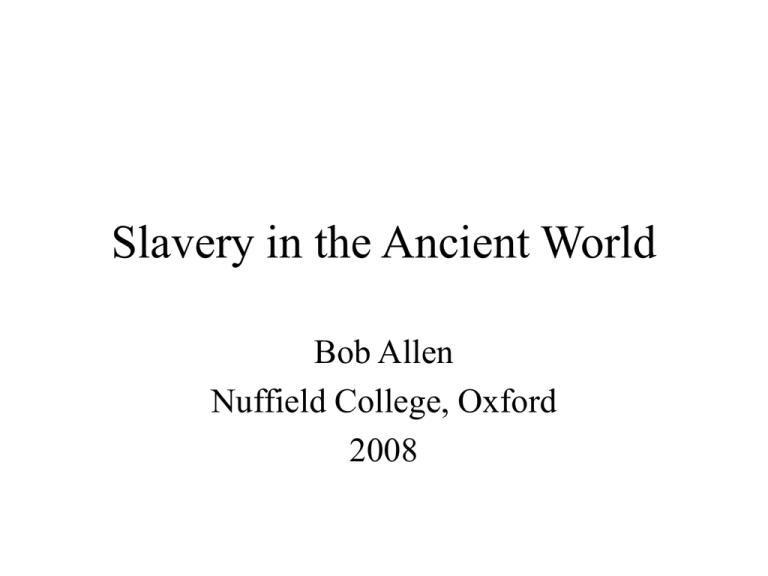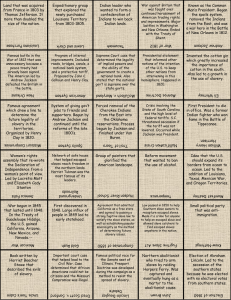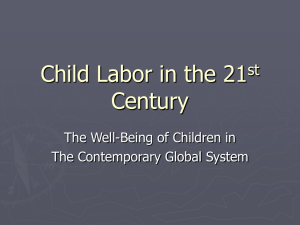
Slavery in the Ancient World
Bob Allen
Nuffield College, Oxford
2008
Slave mode of production
• Second stage in Marxist scheme
• Slavery was extensive in ancient world, at least in
some times and places
– Athens in 5th and 4th century BC
– Italy during expansion of Roman Republic and the Empire
– Slaves may have amounted to one third of the population in
these areas but little exact information.
– Slaves worked in mining and agriculture as well as
domestic service.
Slaves working in Roman agriculture.
Character of slavery varied.
• In Athens and Roman Republic, the main
source of slaves were captured either in war or
bought from victors in other wars and raids.
• In agriculture and mining, treatment was
extremely harsh, sex ratios unbalanced,
families not allowed.
• Slaves revolts were one result.
Greek slave being punished.
Great supply of captive slaves as empire
expanded.
Supply of captive slaves declined as imperial
expansion slowed and then receded.
When expansion slowed, slaves were
bred.
• Estates were reorganized and slaves became
Servi casati.
• Slaves allowed to have houses and families.
• They grew their own food on their own plots.
• Slavery came to look a lot like medieval
serfdom.
Slavery often assumed to inhibit
economic growth.
• This view was propounded most famously by
M.I. Finley in many works.
• Slavery was a pre-capitalistic system of
organization.
• Governed by custom and coercion rather than
economic incentives.
• Absence of a labour market emblematic of
limited role of markets in general.
Questions about ancient slavery:
• Why was it so extensive?
• Why did its organization change?
• What was its impact on economic growth?
We have already seen some standard answers to these questions.
We will re-examine these issues using the
cliometric methods developed to study American
slavery.
• In early modern period, about 12 million
Africans taken to the Americas to work in
plantations.
• About 500,000 of these were in the United
States where they cultivated cotton and other
crops.
Character of slavery depended on the
supply of slaves.
• When slaves were imported freely (and
cheaply), slavery was exceptionally harsh.
• Slave trade abolished in the British Empire in
1807 and in the US in 1808.
• Afterwards, American slave owners
encouraged high fertility.
• US slavery abolished during civil war in
1860s.
An old tradition maintained:
• Slavery was economically irrational.
• Slavery inhibited economic growth.
• Slavery was unprofitable and unviable, so it
would have died out without the Civil War.
• These issues were addressed in a great
research trajectory featuring Conrad & Meyer
(1958), Yasuba (1961), Fogel & Engerman
(1974), and other works.
The historian Ulrich Phillips (1905)
argued that slavery was not viable.
• Slavery was only established because wages were
very high.
• Slave labour was unproductive and worth using only
when slaves could be cheaply imported.
• After the abolition of the slave trade, slave prices rose
relative to cotton prices, and that meant that slavery
was not profitable.
• Slaves were kept only as status symbols—not because
they were economically valuable.
These claims were supported by calculations like
these by Sydnor (1933).
from: R Fogel & S Engerman, Reinterpretation of American Economic History, p. 321.
Weaknesses in the calculation:
• Deducting interest as a cost.
– Eliminating that expense raises profit rate to 8.4%
– What Snydor calculated was the rate of pure profit, which
was positive and equivalent to 8.4% > 6%.
• Not including the value of slave children as a benefit.
• Treating the investment as lasting forever and
deducting depreciation to make it finite may
introduce errors if the depreciation is not consistently
measured.
One of the first papers of the ‘new economic
history’ was Conrad and Meyer’s calculation of
slavery profitability (1958).
• Separate calculations for males and females. I
only consider males here.
• 20 year old male slave cost $1450.
• Cost per year of maintaining him was $20.50.
• Output per slave was 3.75 bales (500 lbs each)
per year.
• Price of cotton was $0.067 per pound, so
annual revenue per slave was $125.625.
We can compute the rate of return:
Slave price = ∑ (annual revenue-annual cost)/(1+i)ⁿ
where summation is from n = 1, 2, 3,…..T
1425 = ∑ (125.625-20.50)/(1+i)ⁿ
where summation is from n = 1, 2, 3,…..35
(ages 20 to 55)
Now solve the equation for i!
Enter the data in Excel and use internal
rate of return function:
age
purchas e
20
21
22
c os t
20. 5
20. 5
20. 5
et cetera
51
52
53
54
55
y ield
pric e$/lb bales@500lbs
rev enue
0.067
0.067
0.067
3.75
3.75
3.75
et cetera
20. 5
20. 5
20. 5
20. 5
20. 5
0.067
0.067
0.067
0.067
0.067
125.625
125.625
125.625
prof it
-1425
105.125
105.125
105.125
et catera
3.75
3.75
3.75
3.75
3.75
125.625
125.625
125.625
125.625
125.625
internal rat e return =
105.125
105.125
105.125
105.125
105.125
6.25%
This rate of return was the same as railway bonds, which shows
that slavery was profitable.
The situation was more complex:
• Since the slave trade was illegal, the supply of
slaves was fixed, and their price was demand
determined.
• The demand price of slaves was the present
values of their net income.
• The Conrad-Meyer calculation simply shows
that slave income was discounted at the
railway bond rate.
Slave price = ∑ (annual revenue-annual cost)/(1+i)ⁿ
where summation is from n = 1, 2, 3,…..T
Substituting $1425 for slave price and solving for i = 6.25% gives
Conrad and Meyer rate of return.
But slave price was set in market by discounting annual net income
with i = .0625.
Slave price = ∑ (125.625-20.50)/(1+.0625)ⁿ
where summation is from n = 1, 2, 3,…..35
Yasuba (1961) pointed out that viability was
different from profitability.
• Viability meant that it was profitable to breed slaves.
• If slavery was viable, the price of the adult slave was
greater than the future value of the cost of rearing
him or her.
• Alternatively, slavery was viable if the present value
of all net revenues from birth to death was greater
than zero.
• The difference, in either case, was the ‘capitalized
rent,’ and positive capitalized rent indicates viability.
• Yasuba did calculations that are hard to reproduce
that show that American slavery was viable.
We can do some of these calculations
with ancient data to address the
questions about ancient slavery.
• Was it profitable to purchase a slave in the
Roman empire? This throws some light on
the question of the ‘customary’ nature of the
economy.
• Was it profitable to breed slaves in ancient
Athens? How about the Roman Principate?
This throws light on how the expansion of
the empire affected the character of slavery.
Rate of return to buying a slave, 1st century AD
(Conrad and Meyer calculation)
age
14
15
16
17
18
19
20
net inc*
s urv iv ors net incomes urv iv ors
-550
-550
1
60
60
0.986128
60 59. 1677
0.972449
60 58. 34695
0.95896
60 57. 53758
0.945657
60 56. 73944
0.93254
60 55. 95237
et cetera et cetera et cetera et cetera
60
61
62
63
64
65
0.310416
0.289752
0.270463
0.252458
0.235652
0.219964
60
60
60
60
60
60
18. 62497
17. 3851
16. 22777
15. 14748
14. 13911
13. 19786
irr (t o 65)= 10. 85%
9.10%
The rate of return of 9.1% looks
plausible.
• Net income is the difference between the
annual earnings of a free labourer and the cost
of maintaining a slave
• Most foundations realized 6% on capital, but a
few realized 12%.
• Slave pricing looks economically rational.
• This counts against Finley view that the
economy was customary.
A Yasuba viability calculation explains
the hutting of slaves.
• In 5th century BC Athens and the Roman Republic,
slaves were very cheap because there were so many
captives.
• The price was so low that it was not profitable to
breed slaves.
• Slavery was ‘not viable’ in Yasuba terms.
• The situation was different as the supply of captives
declined in 1st century AD.
• Then the price of slaves exceeded the cost of rearing
them, and slavery was ‘viable’.
• Hence, servi casati
We need a life table for this (West level 2,
female, exp at birth = 22.5 years)
age x
l(x)
L(x )
0
100000
78290
1
66601
224642
2
3
4
5
50776
244586
6
7
8
9
10
47396
231061
11
12
13
14
15
44930
217375
16
17
18
19
20
41899
201066
21
22
23
24
25
38336
183300
per-y r liv ed
number
per personat st art
0.7829 100000
0.933005
66601
62233.64
58152.66
54339.3
0.990307
50776
50081.25
49396
48720.13
48053.5
0.996087
47396
46892.2
46393.76
45900.62
45412.72
0.99503
44930
44306.75
43692.14
43086.06
42488.38
0.994498
41899
41160.85
40435.7
39723.32
39023.5
0.994138
38336
y ears
liv ed
78290
62139.05
58064.28
54256.72
50698.83
50283.83
49595.81
48917.2
48247.88
47587.72
47210.52
46708.69
46212.2
45720.99
45234.99
44706.71
44086.55
43475
42871.93
42277.23
41668.45
40934.36
40213.2
39504.74
38808.77
38111.27
225158. 9
244632. 4
231087. 4
217417. 4
201129. 5
183369. 1
We also need:
• Interest rate (6%) since future value of a cost
is: FV = cost per year * (1 + i)ⁿ where n is
years to 15
• Cost per year worked out from cost per calorie
per adult and calorie requirement of each age.
• Cost of breeding a 15 year old is sum of the
FV of the costs for the 15 years:
• Cost of 15 year old= ∑(cost/yr)*(1+i)ⁿ,n=1..15
Cost of 15 year old slave
age
0
1
2
3
4
5
6
7
8
9
10
11
12
13
14
15
y ears
liv ed
1.742488
1.383019
1.292328
1.207583
1.128396
1.119159
1.103846
1.088742
1.073846
1.059152
1.050757
1.039588
1.028538
1.017605
1.006788
1
interest
multiplier
2.396558
2.260904
2.132928
2.012196
1.898299
1.790848
1.689479
1.593848
1.50363
1.418519
1.338226
1.262477
1.191016
1.1236
1.06
1
net c os t
denarii/
y ear
8
10
12
15
16
18
20
22
23
25
0
0
0
0
0
0
f uture
v alue
33. 4078
31. 26874
33. 07731
36. 44842
34. 27252
36. 07639
37. 2985
38. 17638
37. 13733
37. 5607
0
0
0
0
0
0
av erage
c alories/ denarii/
day
y ear
unit s/ met ric
pric e
exp
728.5 10. 26334
1274. 5 17. 95556
1873 26. 38742
2550 35. 92521
354.7241 denarii
R om Empire
295.6034 drachma Ancient At hens
Was breeding profitable?
• Not in the age of conquests when slaves were
cheap: The cost of breeding a 15 year old was
296 drachmas > the price of 125-150 drachmas
• Yes after the Roman Empire was established
and stopped expanding. The cost of breeding
was 355 denarii < the price of 500-600 denarii
• Simple economics explains the change in the
character of Roman slavery.
Why was slavery viable?
The Malthusian context
• In the case of breeding, the subsistence income of the slave is
the subsistence for a family.
• This is the same amount as the subsistence wage that would
prevail if the population was in a ‘Malthusian equilibrium’.
– Possible exceptions or slippage?
• Slavery based on breeding new slaves is only viable if the
wage is above subsistence (an Engerman point).
• Slavery was viable in the Roman empire because the economy
generated a high standard of living. This ties in with modern
reassessments of the performance of the Roman economy and
challenges the Finley view.
In the case of slavery based on
captives,
• The system could persist even if the wage was
at ‘subsistence’.
• ‘Subsistence’ in this sentence means
subsistence for a family.
• Since the slaves are not expected to reproduce
in the captive system, the income of the slave
is only enough to support a single individual.
• This is about one third of the ‘subsistence’ for
a family.










